Last Updated on January 24, 2024
A road where 200 to 300 people are killed every year. Let me repeat this: 200 to 200 people EVERY YEAR. When I read about the Death Road for the first time, I felt distressed, and was freaked out about traveling on this narrow road when we would make it to Bolivia. Officially known as the Yungas Road, it winds through the mountains from Bolivia’s Yungas region all the way down to Coroico in the jungle region of the Amazon.
Bolivia’s Death Road: The World’s Most Dangerous Road
The road, which is not even asphalted, is actually not very long – only 43 miles (69 km), and yet, there have been so many accidents that it is lined with crosses. Entire buses and trucks dropped off the cliffs regularly, never to be seen again. This is how the road earned the dubious title of the World’s Most Dangerous Road in 1995.
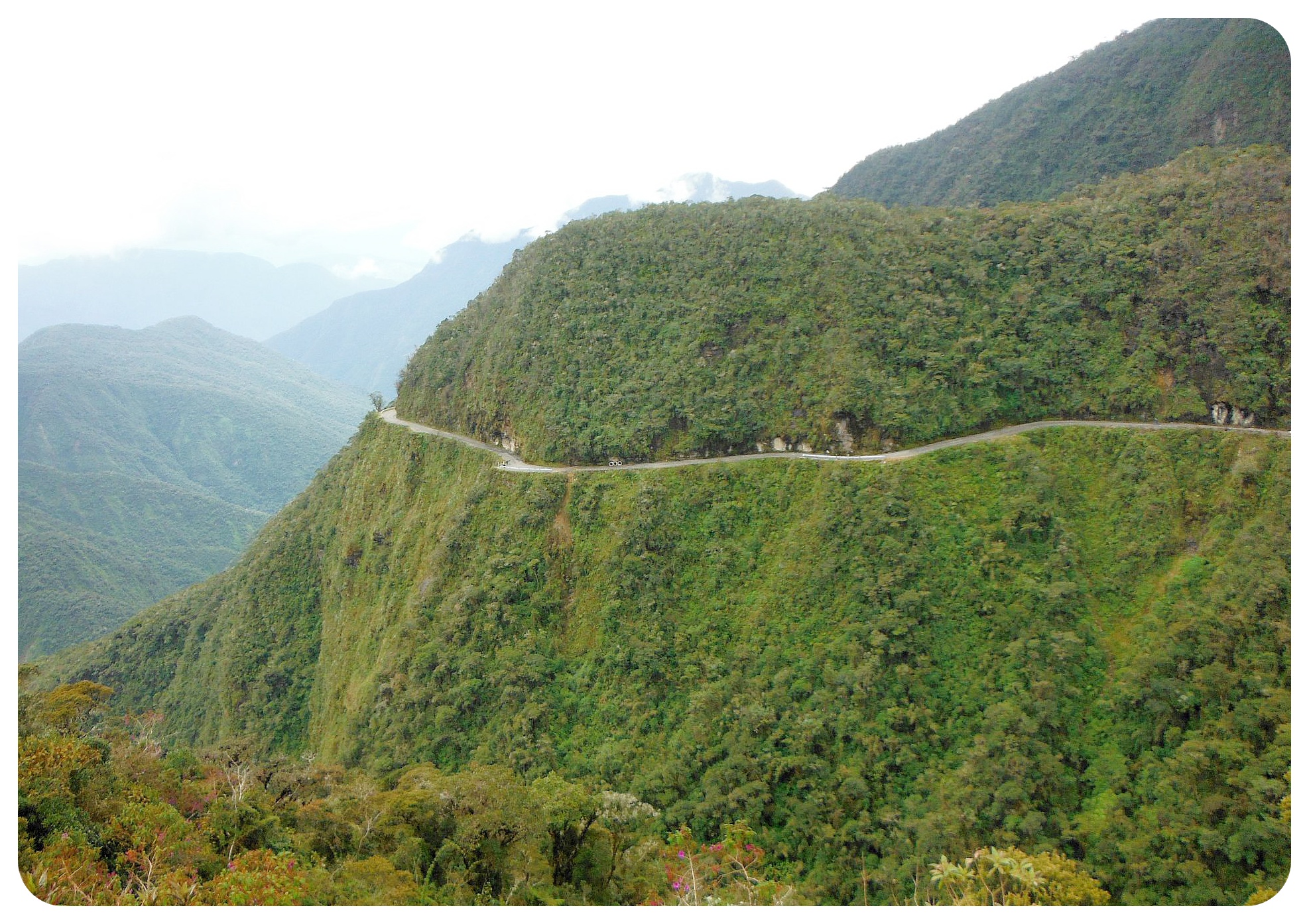 When we started to plan our trip through South America, I found out that you can now cycle Bolivia’s Death Road – an
When we started to plan our trip through South America, I found out that you can now cycle Bolivia’s Death Road – an agonizing leisurely 40-miles (64 kilometers) bike ride along the 2,000 feet (600 meter) deep cliffs, surrounded by lush green mountains and what was supposed to be some of Bolivia’s most stunning scenery. I was terrified and intrigued at the same time.
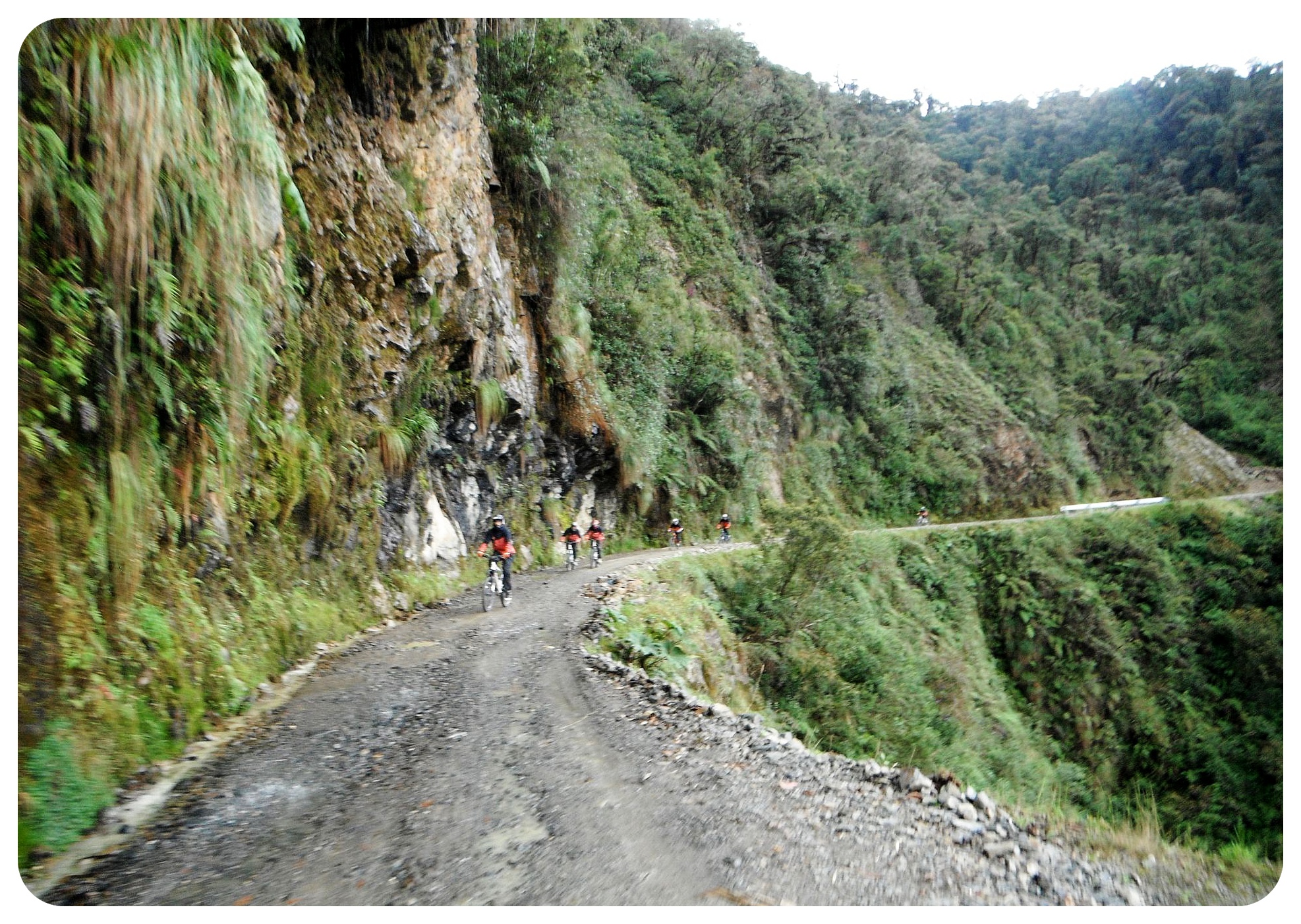 I later learned that the original Death Road had been replaced by a new, safer (asphalted!) road several years ago and was mainly used by thrill-seeking cyclists these days. Car traffic was apparently minimal – so the deal was sealed. The thought of cycling Bolivia’s Death Road didn’t seem as terrifying anymore now that I knew that I couldn’t collide with a truck or bus.
I later learned that the original Death Road had been replaced by a new, safer (asphalted!) road several years ago and was mainly used by thrill-seeking cyclists these days. Car traffic was apparently minimal – so the deal was sealed. The thought of cycling Bolivia’s Death Road didn’t seem as terrifying anymore now that I knew that I couldn’t collide with a truck or bus.
Of course I could still drop off a cliff, since most of the road doesn’t have any guard rails, but I figured with some caution I would be fine. When the road was still in heavy use, the main reason for accidents was that in many spots it was too narrow for two vehicles to pass each other at the same time, causing the bus or truck on the cliff side to fall off.
A leisurely bike ride along a 2,000 feet deep cliff
And so I found myself in a minivan leaving La Paz for the mountains on a gloomy morning, along with a few other travelers who were stupid brave enough to take on the Death Road by bike. Our group of foolish daredevils consisted of Jess and me, a German couple, a French couple, a Bolivian couple, a young American solo traveler and a Brazilian guy.
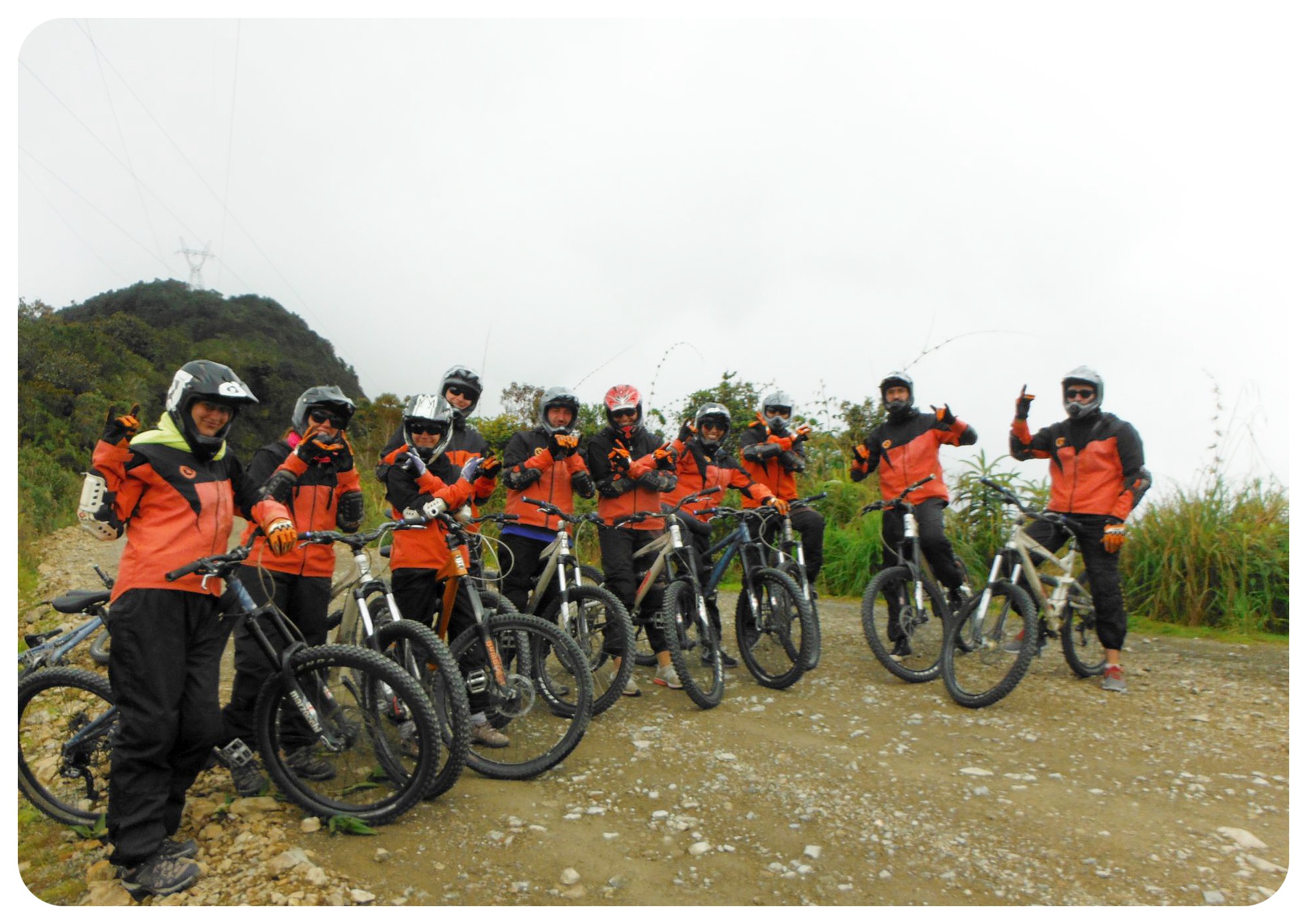
Cycling Bolivia’s Death Road
We started at La Cumbre, the highest point of the mountain range at 15,320 feet (4,670m). Our end point would be in Coroico, 12,000 feet lower than La Cumbre, at 2,950 feet (900 meters) – a crazy difference in altitude! We even had been told to bring bikinis to relax in a swimming pool in tropical surroundings after the ride – something that seemed completely ridiculous when we were shivering up on top of the mountain in the cold of the early morning.
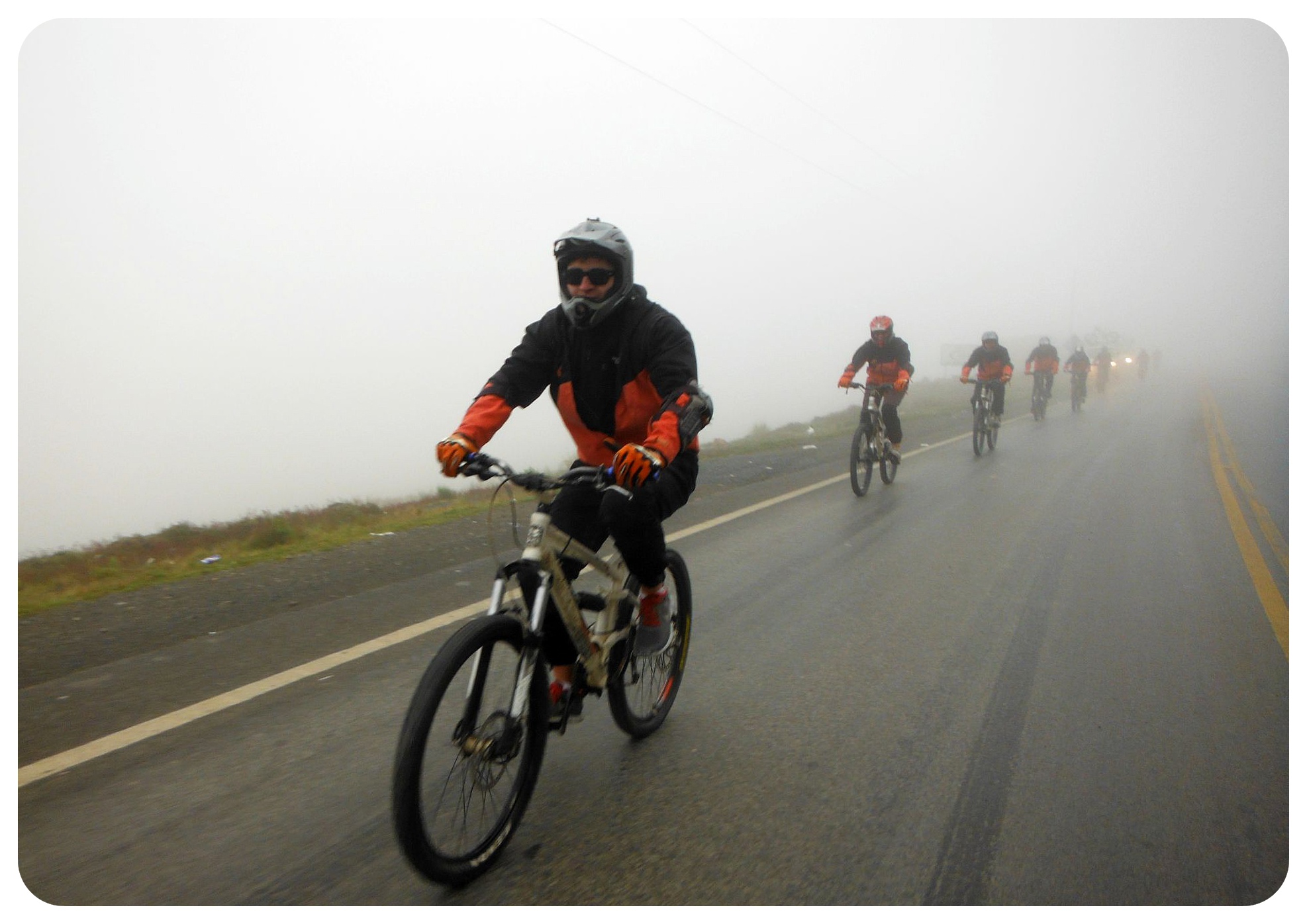 We were fitted into our gear – a jacket with elbow pads, pants with knee pads, gloves, and a full-face helmet, tested our mountain bikes (the brakes worked great, which was excellent news!) and off we went.
We were fitted into our gear – a jacket with elbow pads, pants with knee pads, gloves, and a full-face helmet, tested our mountain bikes (the brakes worked great, which was excellent news!) and off we went.
For the first 20 kilometers we didn’t cycle on the actual Death Road, but on the new asphalt road to Coroico, to get used to the bikes. This part should have been an easy ride, but it was so foggy that you could barely see anything. I prayed that the fog would lift by the time we’d reach the Death Road. What if we weren’t even able to see the steep drop?
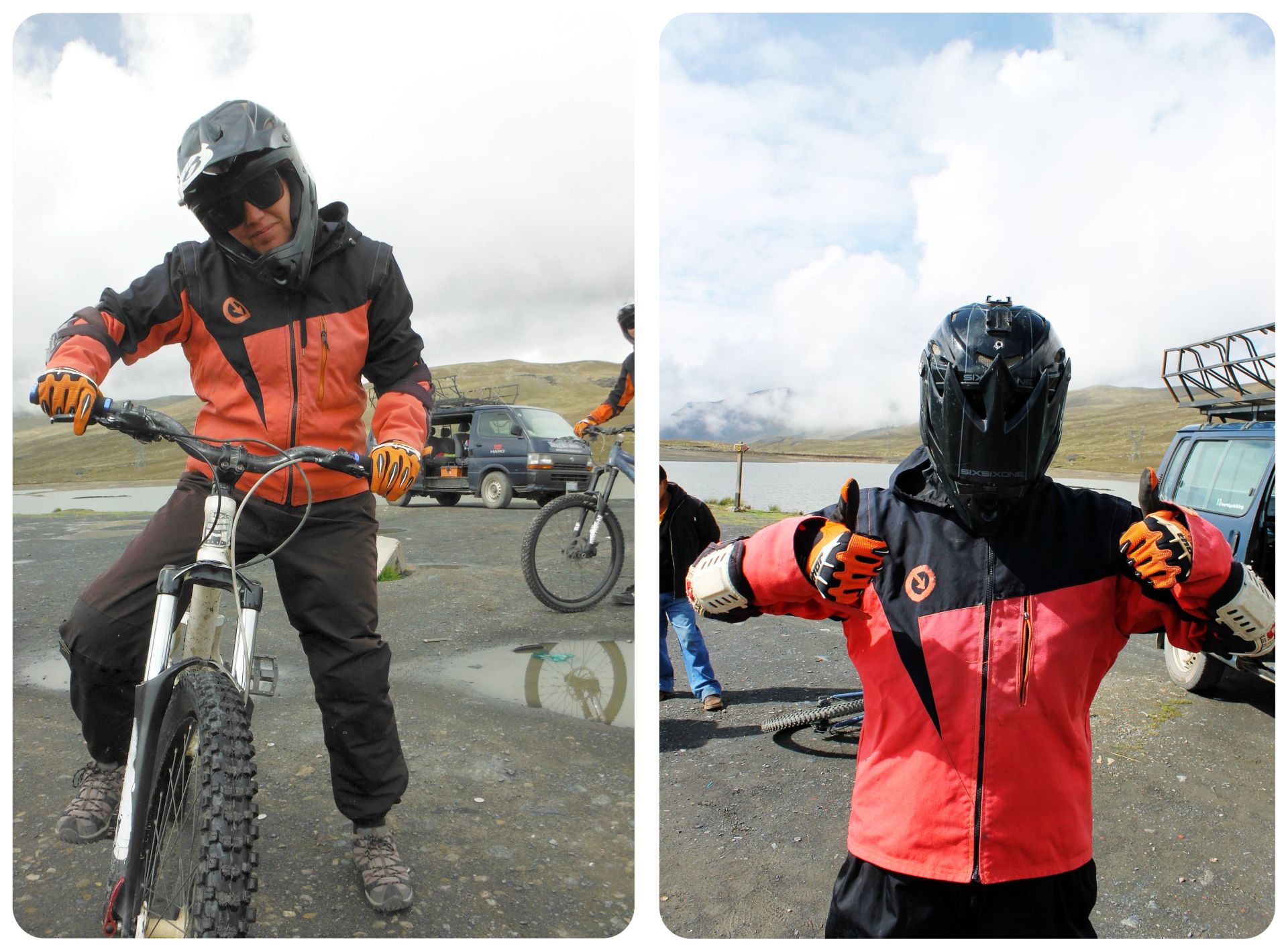
Fog and rain – nightmare #1
In terms of actual cycling, this part turned to be easy, since we basically just rolled down the mountain while holding down the brakes. At this point we were so cold that our fingers were completely stiff from holding on to the brakes so hard.
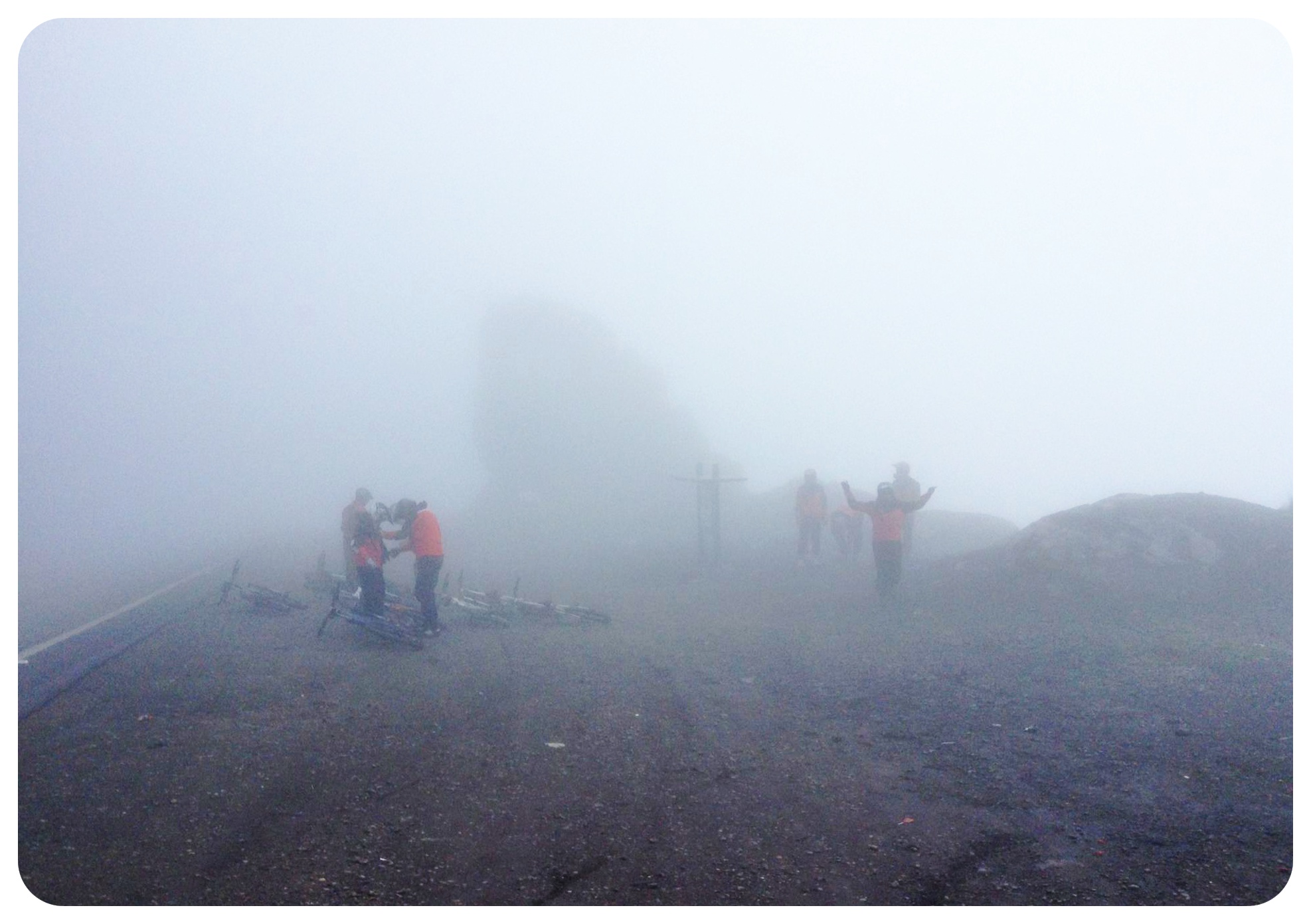 The weather gods didn’t seem to be on our side that day – as if the fog was not enough, it started to rain. After riding through the fog and rain for an hour and getting close to freezing to death before even reaching the Death Road, we stopped for a snack in a little village while the bikes were loaded up on the van. The next 8 kilometers were uphill, and since it was pouring now, we got to ride in the van for a few minutes.
The weather gods didn’t seem to be on our side that day – as if the fog was not enough, it started to rain. After riding through the fog and rain for an hour and getting close to freezing to death before even reaching the Death Road, we stopped for a snack in a little village while the bikes were loaded up on the van. The next 8 kilometers were uphill, and since it was pouring now, we got to ride in the van for a few minutes.
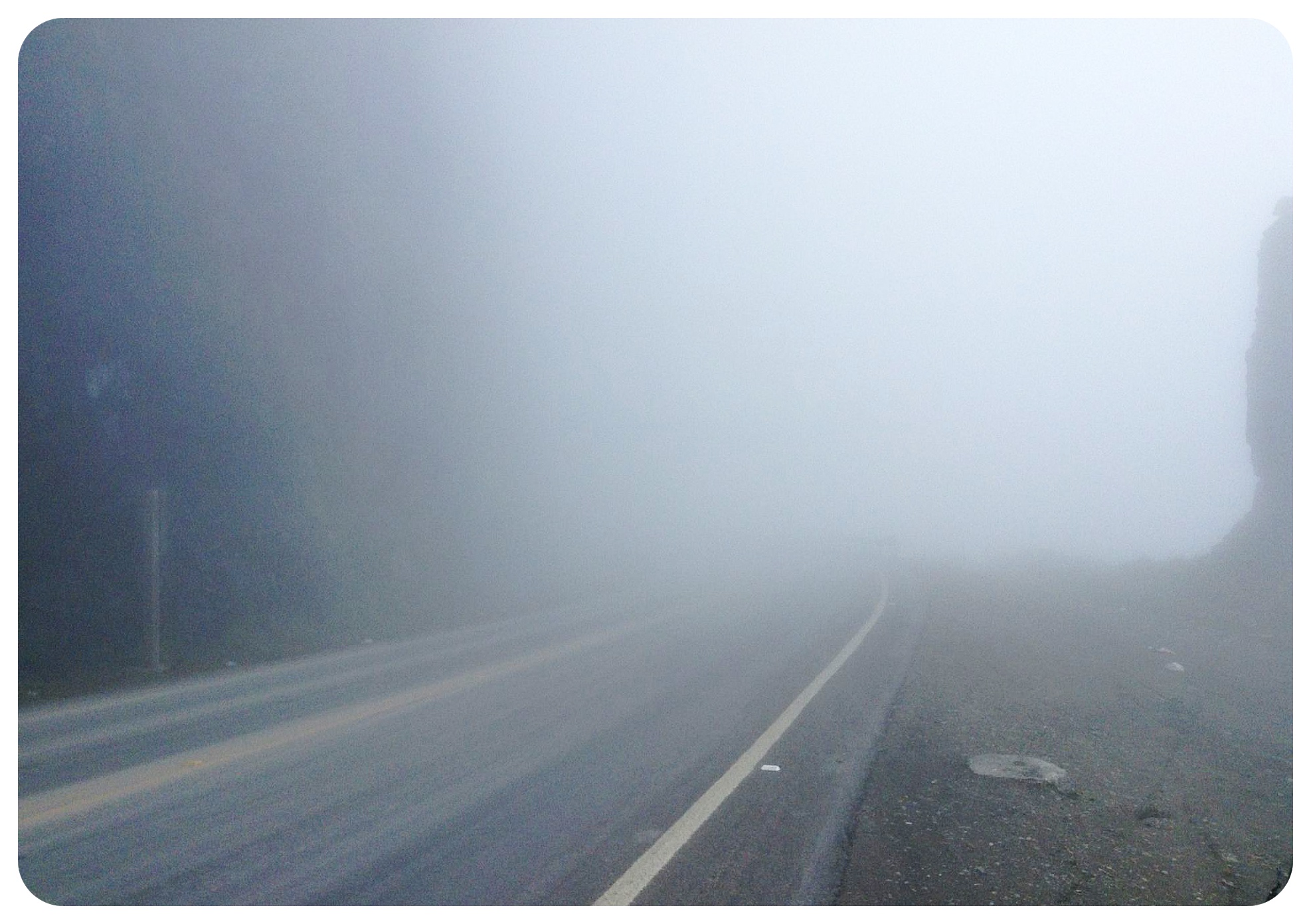 Then we arrived at the original Death Road. The fog had lifted, and we could see the road snake along the mountainside for miles, with imposing cliffs on the left side of the road. I started to feel a little uneasy, especially when our guide told us that we’d be riding on the left – the cliff – side of the road!
Then we arrived at the original Death Road. The fog had lifted, and we could see the road snake along the mountainside for miles, with imposing cliffs on the left side of the road. I started to feel a little uneasy, especially when our guide told us that we’d be riding on the left – the cliff – side of the road!
This is the only road in Bolivia with left-hand traffic, the reason for this being that drivers who ride on the left see the cliff (since the steering wheel is still on the left side), and drivers who come up the road see how close they’re to the mountainside.
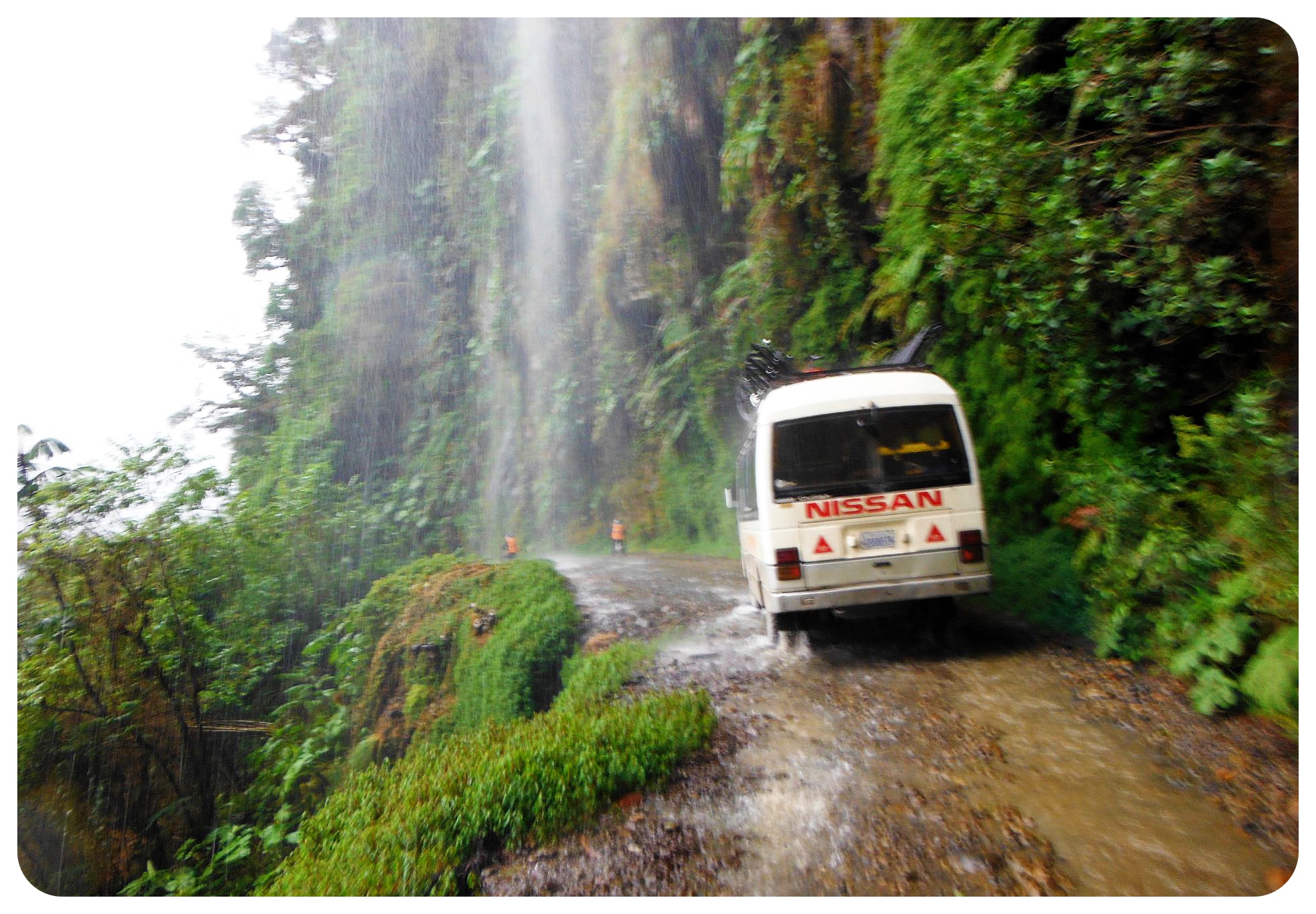
Oncoming traffic on the Death Road – nightmare #2
We also learned that since a landslide had covered part of the new road eleven months ago and the clean-up was still ongoing, trucks and local cars were using the death road again! This meant there would be oncoming traffic. I have to admit that had I known this before, I would probably NOT have signed up to do the Death Road by bike.
I felt a bit better when our guide announced: ‘This is a tour, not a race. Take your time and enjoy the scenery.’ After being passed by some of the other tour groups, I realized that they saw this ride as a race, speeding down the hill as if it was about making it first over the finish line rather than alive and in one piece.
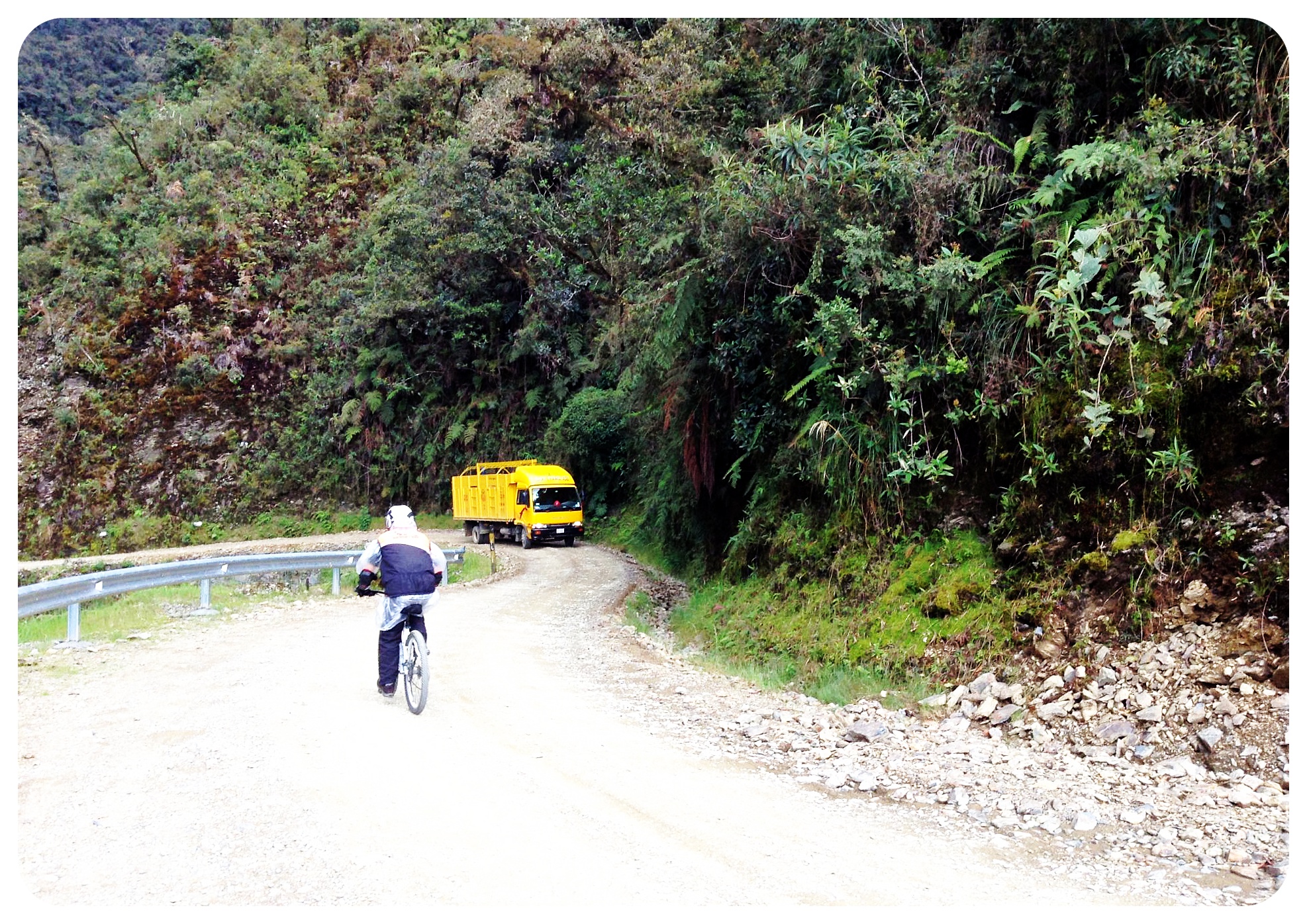 Luckily the rain had stopped, and so we started the ride in good spirits. Every time I dared to look down to my left, it resulted in my heart racing and sweaty palms. The drop was unbelievably steep, and you couldn’t see the bottom.
Luckily the rain had stopped, and so we started the ride in good spirits. Every time I dared to look down to my left, it resulted in my heart racing and sweaty palms. The drop was unbelievably steep, and you couldn’t see the bottom.
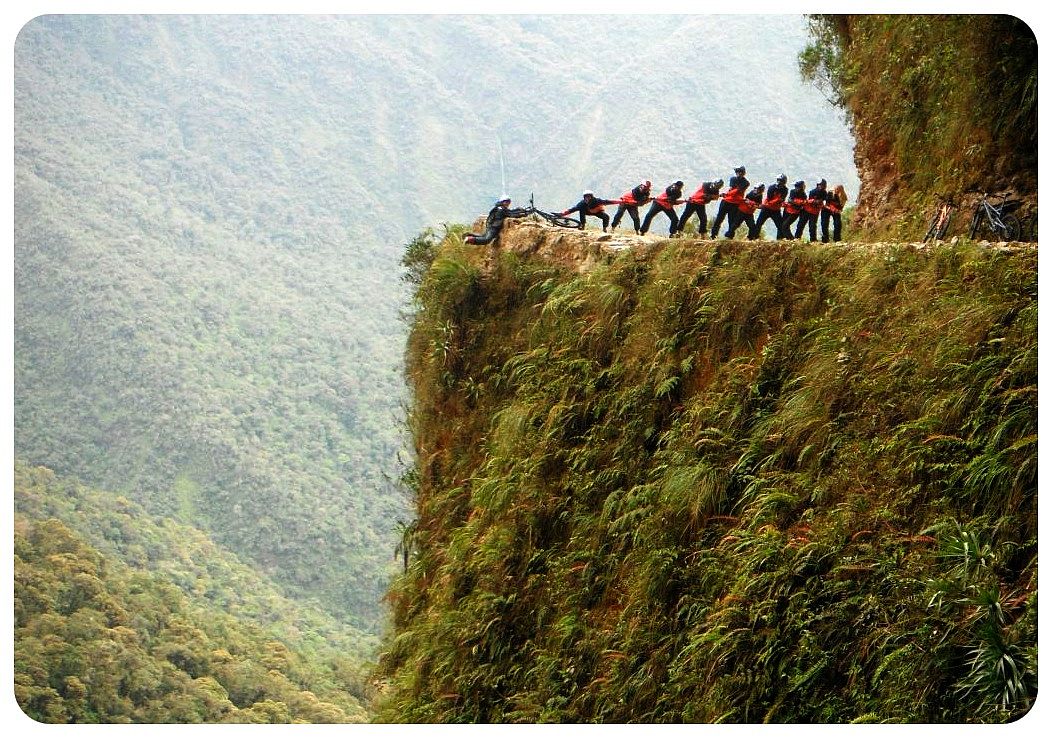 We stopped several times to take photos – most of the time our guides took photos of all of us, since we were too busy holding on to the brakes and our camera gear was in the van that was following slowly behind us. After cycling for a while we were even relaxed enough to pose for some goofy photos at the edge.
We stopped several times to take photos – most of the time our guides took photos of all of us, since we were too busy holding on to the brakes and our camera gear was in the van that was following slowly behind us. After cycling for a while we were even relaxed enough to pose for some goofy photos at the edge.
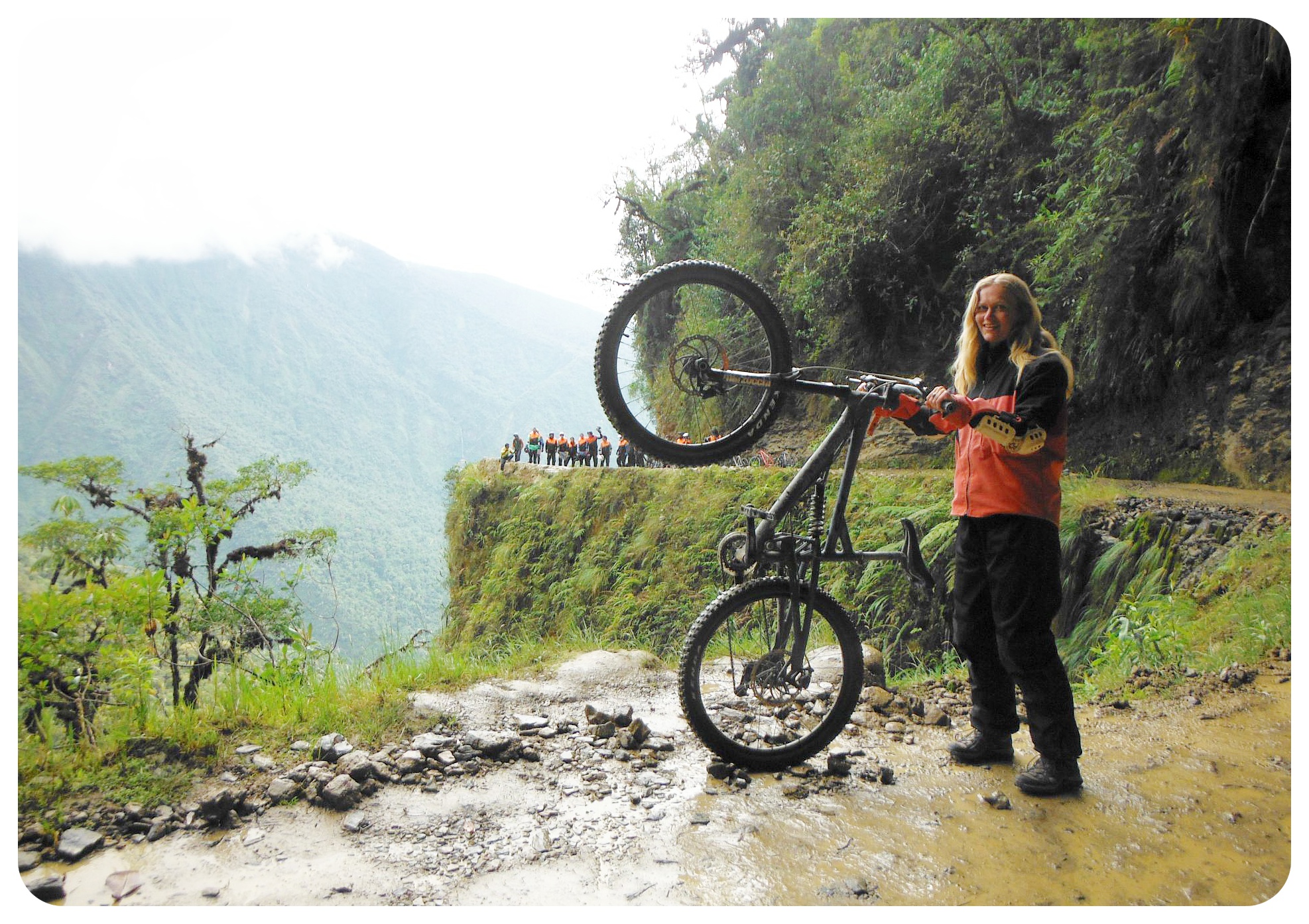
Not one, but two accidents
The scariest moments were when cyclists of another group tried to pass us. There were eleven or twelve groups with around ten cyclists each, which means in total, well over one hundred people were biking down the road that day (and every other day of the year, in fact).
We were supposed to yell ‘Passing on your left’ or ‘Passing on your right’ when overtaking other cyclists, but not all of them did that when they passed us. Some would just appear scarily close to my right – seemingly out of nowhere, at lightening speed, causing rocks to fly against my bike, which can result in ugly accidents.
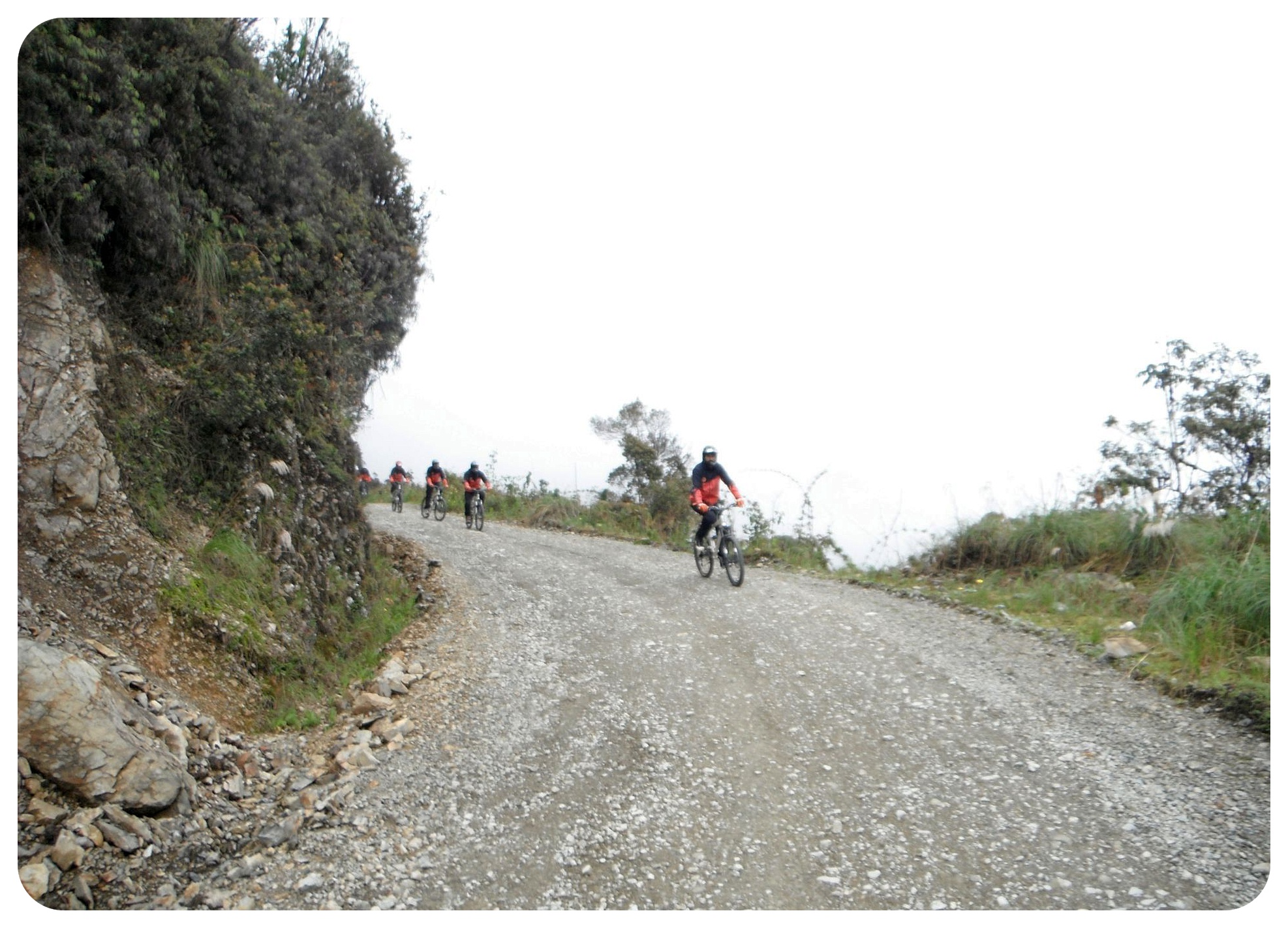 Our group of ten had two guides, and Jess and I were riding slower in the back with the Bolivian couple, and while one guide was riding with the daredevils of the group, the other guide was always in the back with us. The other six were much more daring than we were and were always way ahead of us – whenever you could see the road ahead of us on a less winding part, they were nowhere to be seen.
Our group of ten had two guides, and Jess and I were riding slower in the back with the Bolivian couple, and while one guide was riding with the daredevils of the group, the other guide was always in the back with us. The other six were much more daring than we were and were always way ahead of us – whenever you could see the road ahead of us on a less winding part, they were nowhere to be seen.
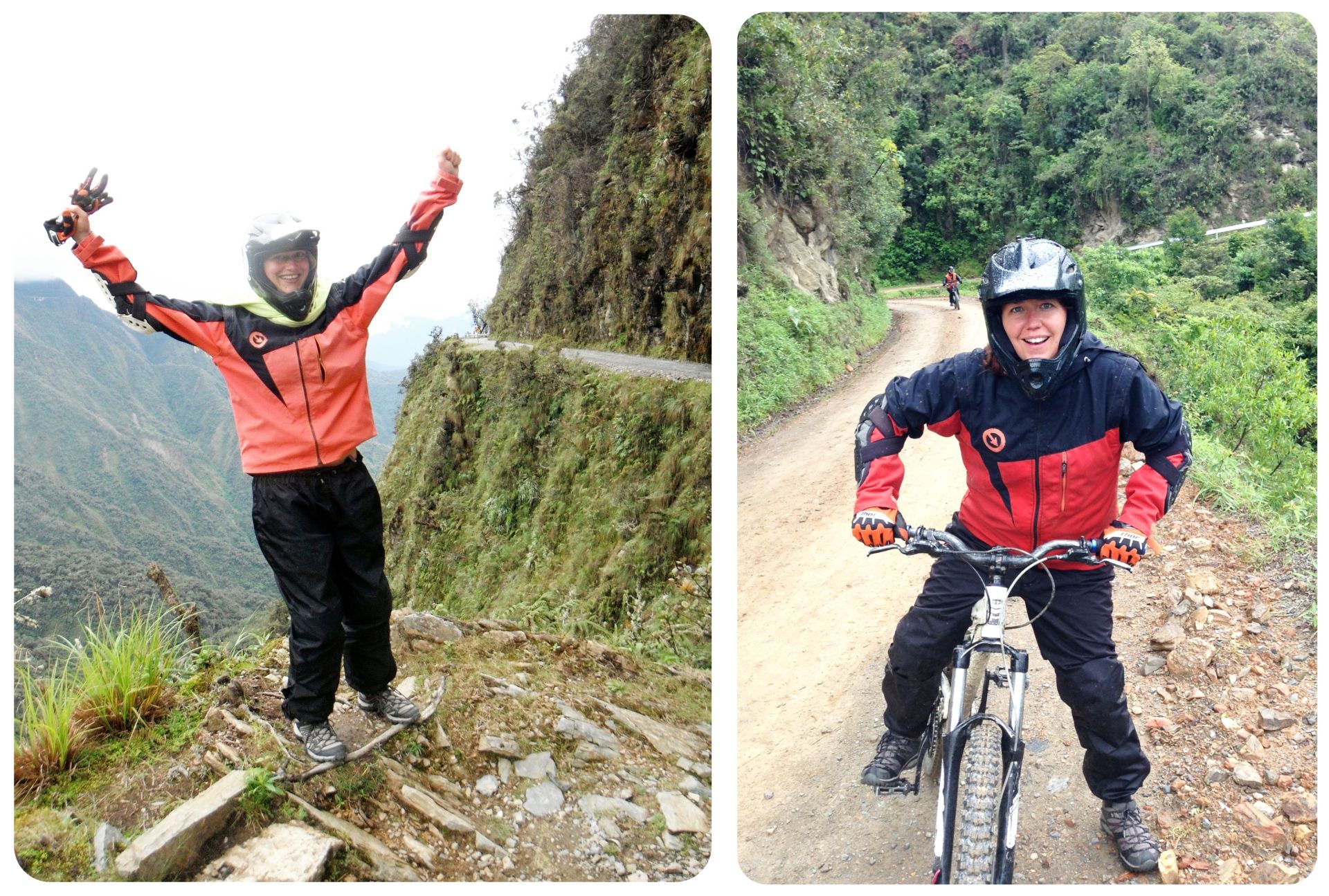 After about two thirds of the way, we rode on a flat part for a while – the first time all day that we had to use our pedals! Most of the time we just sat on the bike and hit the brakes hard, trying not to go over the edge. Because there are so many curves on the way, the cars that come up the road usually honk before turning around a corner.
After about two thirds of the way, we rode on a flat part for a while – the first time all day that we had to use our pedals! Most of the time we just sat on the bike and hit the brakes hard, trying not to go over the edge. Because there are so many curves on the way, the cars that come up the road usually honk before turning around a corner.
At some point, a car turned around the corner so suddenly that the sound of honk took me by such surprise that I hit the brakes too hard – and I flew over the handlebars. Luckily I didn’t go over the edge and was able to catch the bike before it went over, making this an incident without a tragic outcome (except for me being terribly shaken up with visions of me on a rock at the bottom of the mountain).
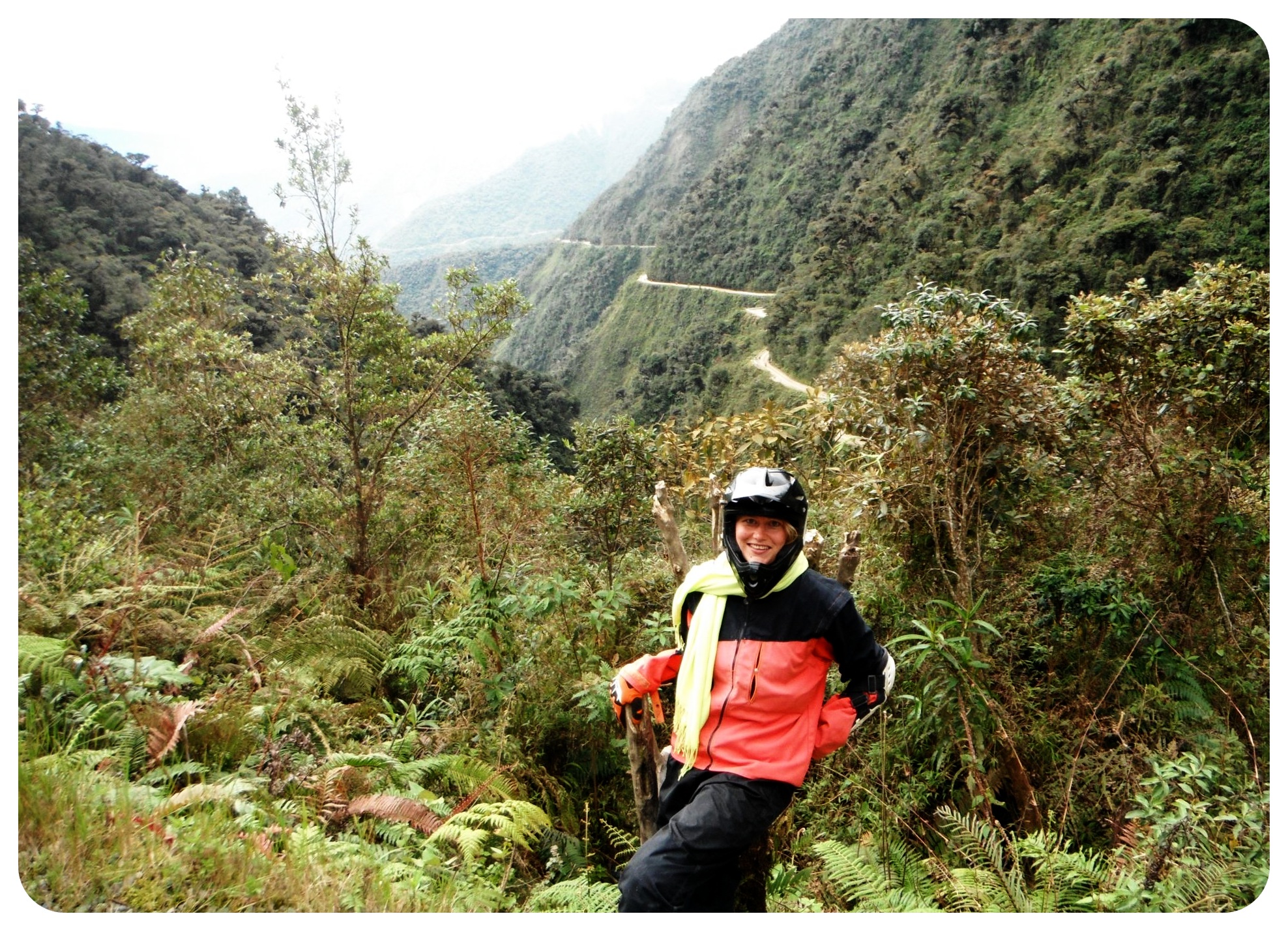 Not long after that, I heard a loud crash behind me and when I turned around, I saw Jess on the ground, her bike upside down in the slope next to her. It turned out that she had also been lucky and the accident looked much worse than it was – a minute later she was back in the saddle and raced towards the end, having become much more comfortable than me on the bike.
Not long after that, I heard a loud crash behind me and when I turned around, I saw Jess on the ground, her bike upside down in the slope next to her. It turned out that she had also been lucky and the accident looked much worse than it was – a minute later she was back in the saddle and raced towards the end, having become much more comfortable than me on the bike.
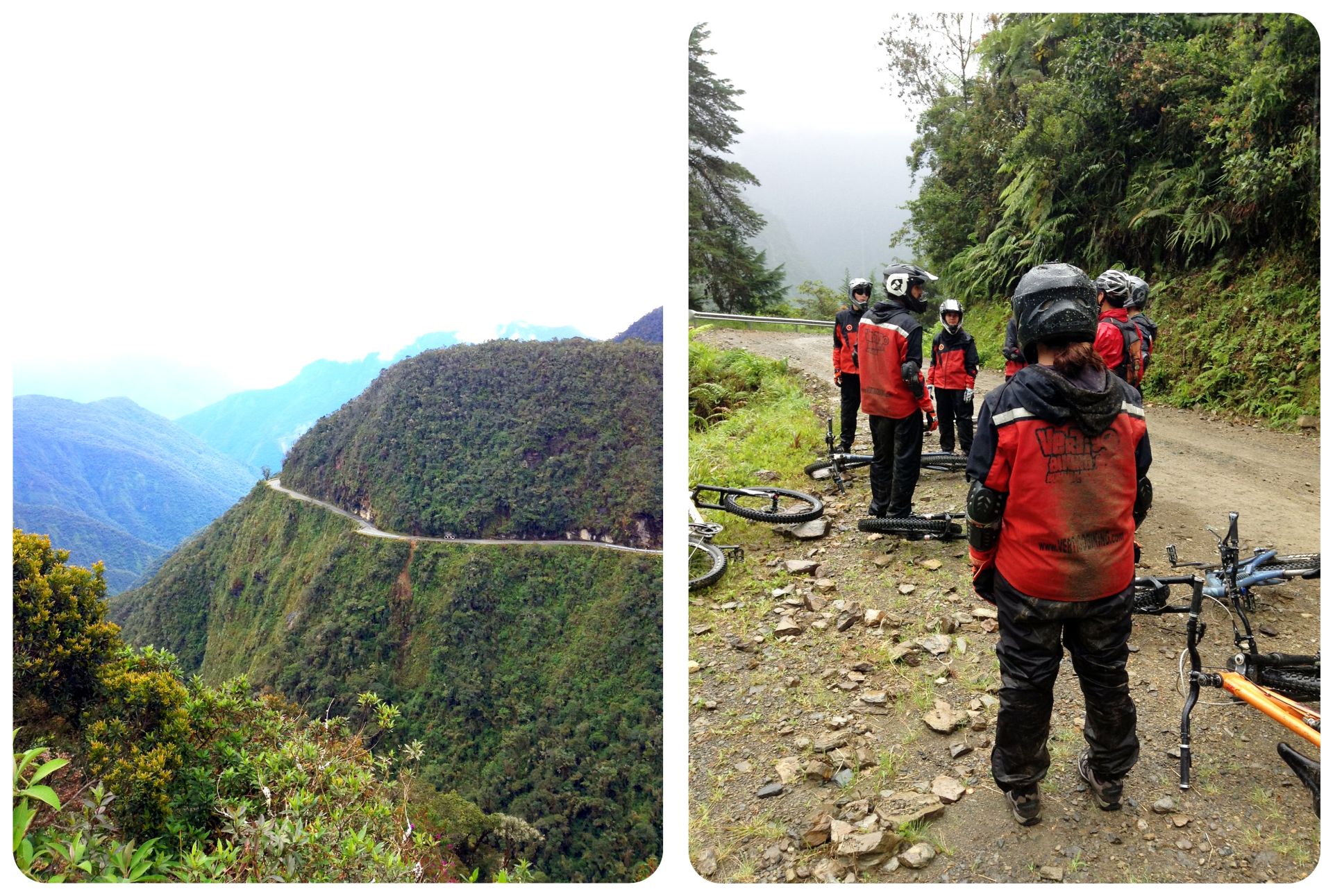 A few minutes later, we arrived at the main road – we had survived the Death Road! Not quite accident-free, but we lived.
A few minutes later, we arrived at the main road – we had survived the Death Road! Not quite accident-free, but we lived.
All of the Death Road cycling tours include a buffet lunch at a hotel with a swimming pool in the valley, and our group celebrated our survival over some beers and lunch – though it was already late afternoon. Somehow it had taken us much longer than the two to three hours we’d been told to cycle down the road.

The Death Toll Is Still Rising
Before we drove back to La Paz, our guide told us that the day before, a guy had gone over the edge – he lived, but was in the hospital with several broken bones. He had cycled with a company called Overdose, whose group we had met briefly early in the morning, and we weren’t surprised to hear that it was this company – they were among those cyclists that were racing down the road at full speed.
We learned that in addition to the thousands of people who had died in cars and buses on the Yungas Road, 21 cyclists and 5 guides have died since the road had been opened for mountain bike trips. It might not be the most dangerous road in the world anymore, but it is still the Death Road.
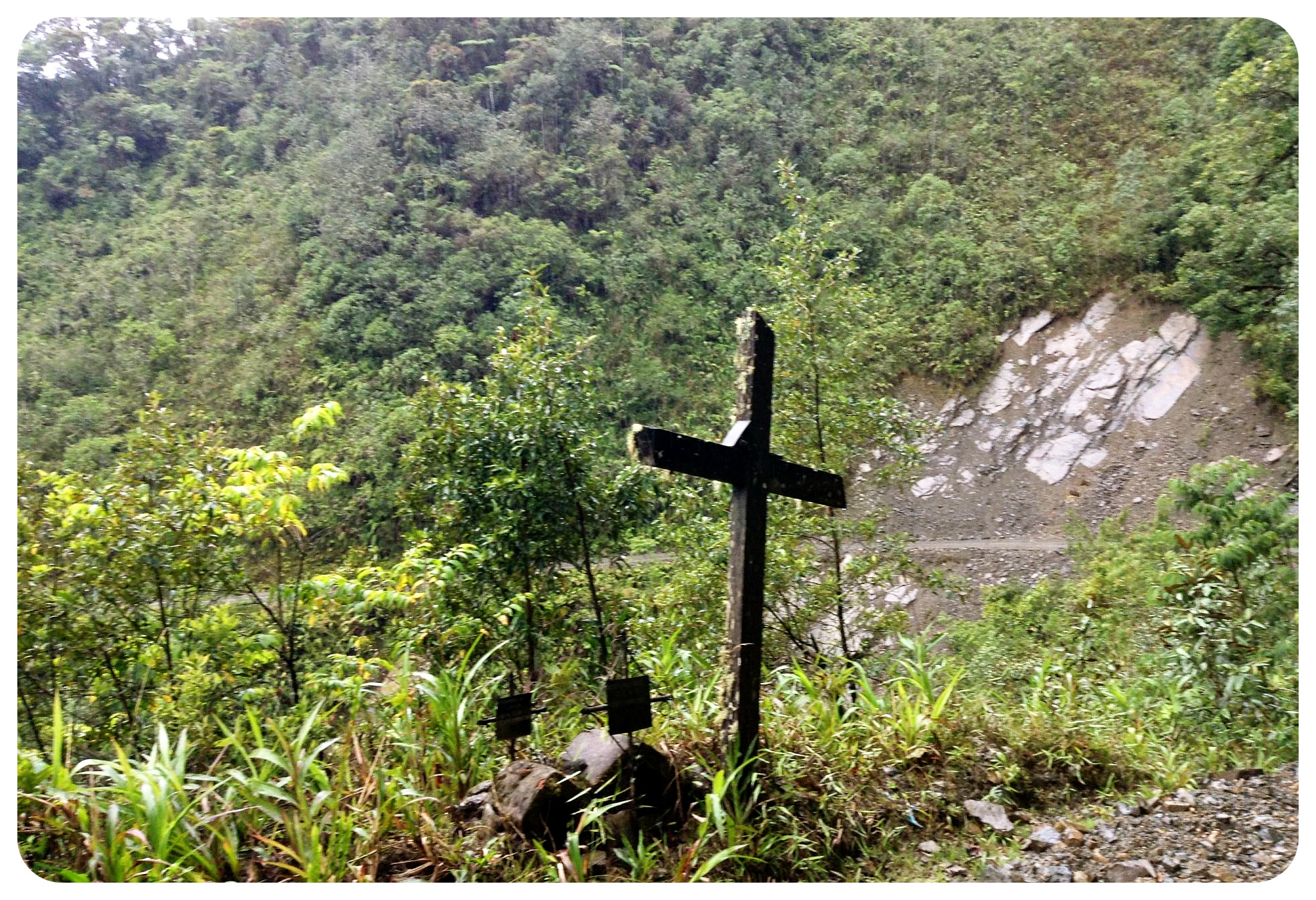
Tips on surviving cycling Bolivia’s Death Road
Keep in mind that even though between one and two hundred people survive the death road every single day, accidents also occur on a daily basis.
Choose a good tour company
Make sure to choose a tour company that provides you with full safety gear, especially a full-face helmet. The most expensive tour company, Gravity, only provides vests and not always full-face helmets – you can read here what this can result in.
Go Slow!
Cycle at your own pace and be careful when passing other cyclists. There’s no reason to rush down this road – instead, take in your beautiful surroundings. This is most likely the only time in your life you get to see this part of Bolivia. Make the most of it.
Don’t cycle with your phone in your hands!
Don’t try to take pictures or videos while cycling! That is one of the most common reasons for accidents, but more people than you’d like to think are tempted to record themselves on the way down. Only do that if you are wearing a helmet cam (goPro).
Check Tripadvisor
Check Tripadvisor and Google Reviews for the latest reviews for the company of your choice before booking your trip. The quality of a highly rated company can go downhill quickly if they don’t take care of their equipment.
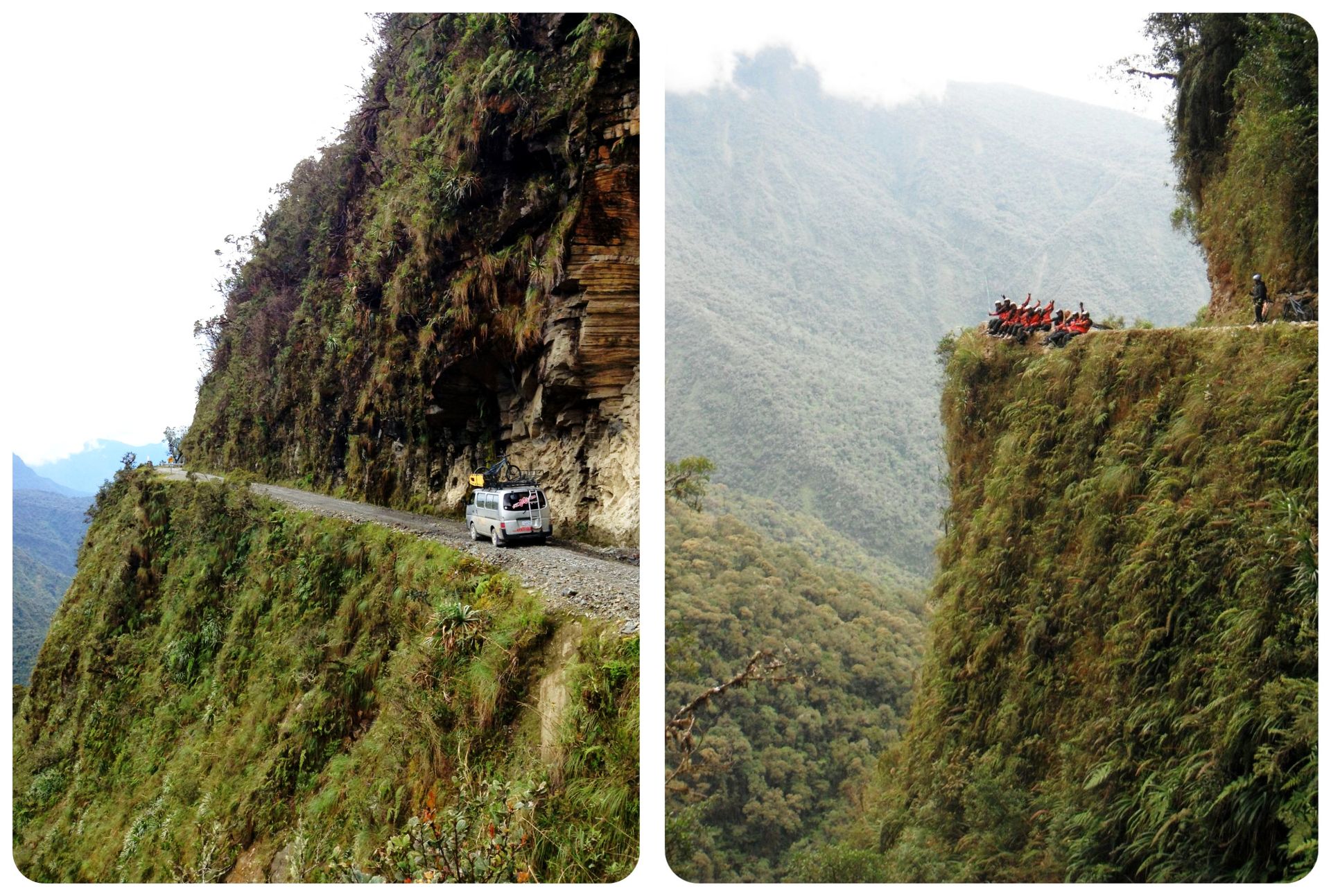
Cycling Bolivia’s Death Road – which tour company to use
We went with Vertigo Biking, and were happy with the service they provided. The bikes (Haro mountain bikes) were excellent and I was thankful for the full-face helmet.
Vertigo charges 480 Bolivianos (around US$70) for the Death Road trip, which includes a snack, full lunch buffet, a T-Shirt and a CD with all photos of the day.

Would you consider cycling Bolivia’s Death Road? Or have you been to Bolivia and are the proud owner of an ‘I survived the Death Road’ T-Shirt, too? Share your experience in the comments below!
Thanks to our guide Kenneth for taking some great shots of our group!
PIN IT!


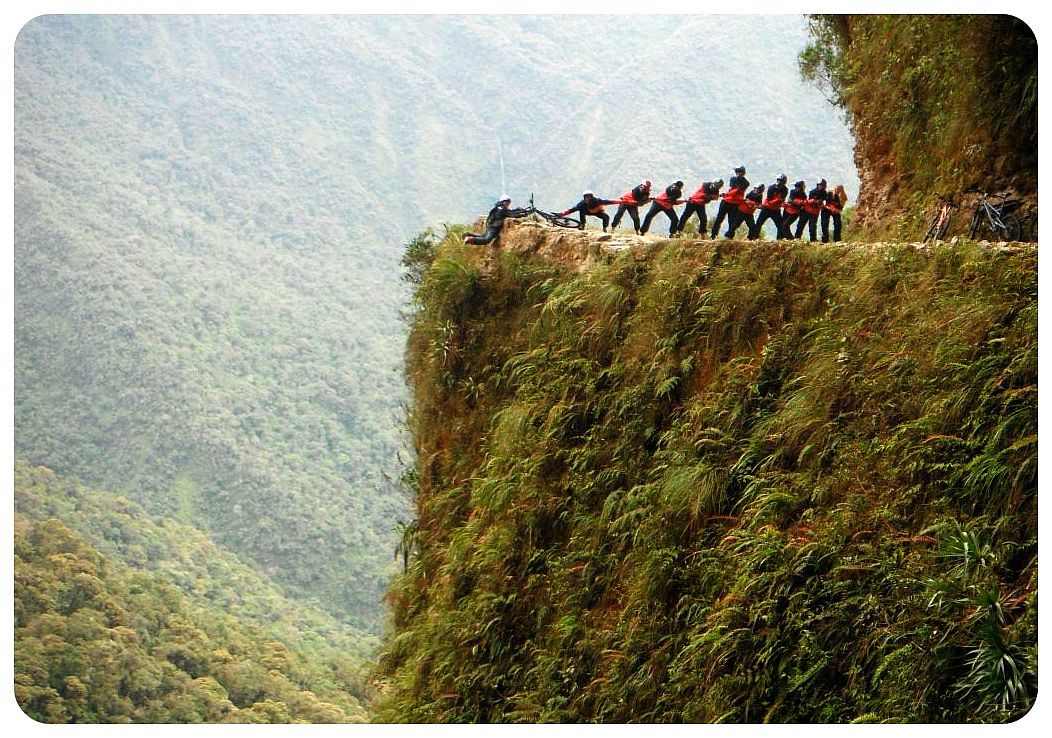
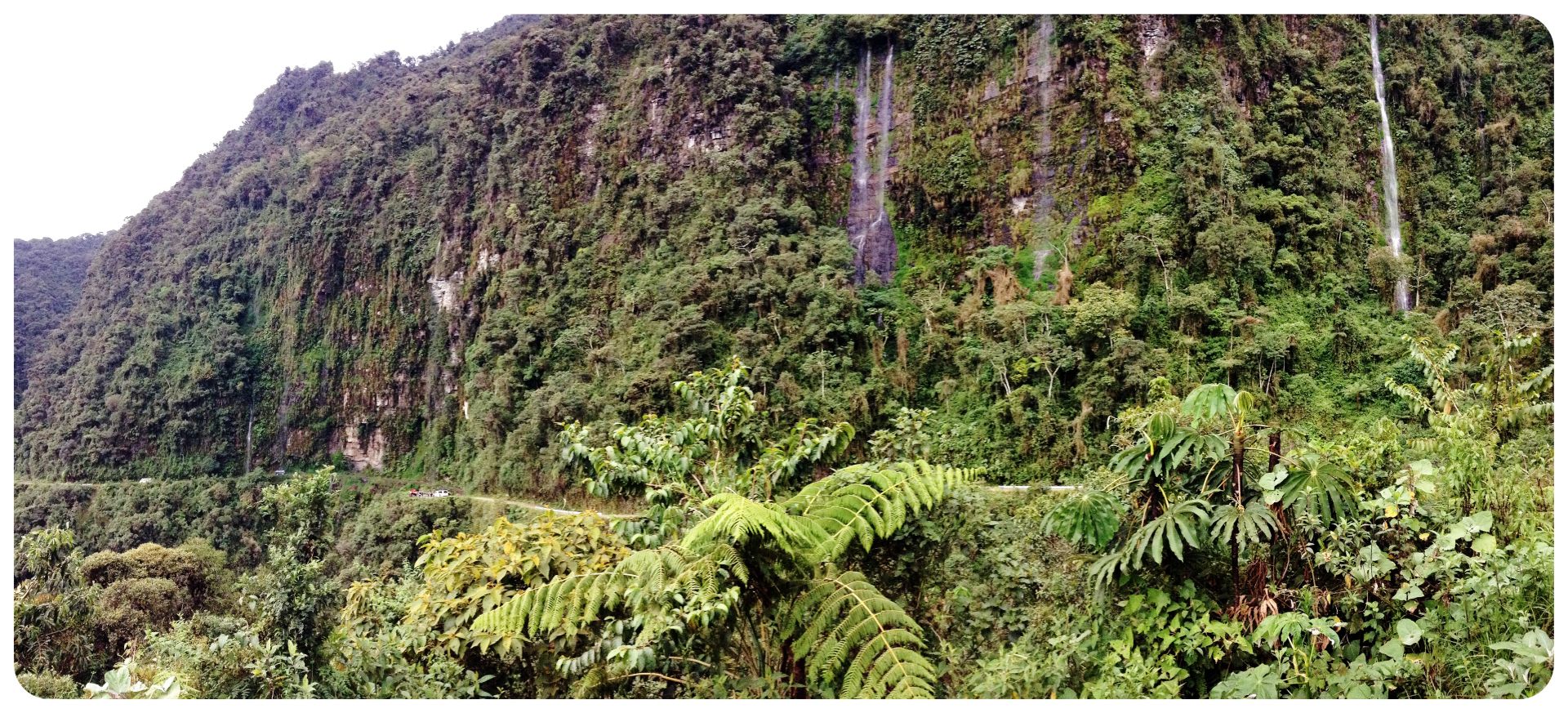

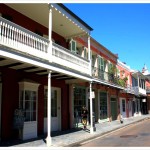

Board in the World
Monday 26th of July 2021
What an awesome adventure! We've read about this road many times, and watched a good amount of shows about it. Would love to visit it in person some day. This looks like it was truly an experience to remember. Would be lying if we said we weren't a little jealous.
30-day South America Backpacking Itinerary for Peru, Chile and Bolivia
Tuesday 3rd of September 2019
[…] Survive downhill biking on Death Road […]
Tam
Sunday 21st of May 2017
Great post and advice! I just did the Death Road yesterday and had a fantastic time. I admit I was a lot more scared than necessary at first but then relaxed. That is, until two people on our tour were taken away on ambulances. Yikes! Wonderful tips and glad you survived!! I hope you don't mind but I linked your blog on my own about the Death Road :) Thanks again!
PS. I think it's important to know that 200-300 people don't die anymore on the road. That was the case in the 80s but between the new road and guard rails, things have vastly improved. Since dangerous though (as my tour group found out!)
Tam @ http://freshcoffeestains.com/death-road/
Dani
Tuesday 30th of May 2017
Hi Tam, wow!! That's insane, what happened to them? A bad fall? I am so glad you survived! I have to re-read my article.. I thought I had made it clear that those are the numbers of people who used to die there, but not anymore.
Life Lately & Upcoming Travels: March 2017 Edition | GlobetrotterGirls
Saturday 6th of May 2017
[…] to the refugio followed by cycling down the volcano. Well, that sounded even better! I enjoyed my bike ride down the death road a few years back, so why not cycle down a volcano? Sadly the tours were only offered on Fridays, […]
Elizabeth Woods
Friday 27th of January 2017
Hey There, this is a great piece, I am just researching now for our family trip later this year. I would love to do Deat Road although it scares the bejeezus outta me. I have two boys who will be 16 and 17 when we go .... tell me honestly what are your thoughts about going with teenagers?
Cheers! Elizabeth X